Time Fast II Chrome

INTRO
Introducing Time Fast II in Chrome by L’Epée 1839: At the crossroads of Racecars and Art
From the Ferrari 250 Testarossa, to the Lamborghini Miura, the 1960s undoubtedly witnessed the pinnacle of design for racing cars, showcasing the epitome of automotive aesthetics.
L'Epée 1839 chose to embrace this thematic with the introduction of the Time Fast II in Silver Chrome. With its sleek and reflective surface, Time Fast II shifts its artistic dimension from a demonstrative to a more evocative kinetic art piece.
THE STORY
Celebrating the Iconic Lines of 1960’s racing cars
The Chrome, renowned in the automotive industry for its ability to elevate car parts, finds new expression in the skilled hands of L’Epée 1839, as it adorns the full bodywork, reminiscing the iconic lines of 1960’s race car models.
The 1960s was a golden age for sports car performance and sleek sensual design.
And it was probably in 1960s when the most beautiful cars were ever made.
Sports car racing features cars that have two seats and enclosed wheels, and they usually run over relatively large distances so there is an emphasis on reliability and efficiency.
Sports car racing in the 1960s was responsible for the now mythical reputations of racetracks like Le Mans, Sebring and Daytona. And it cemented the reputations of the most prestigious car manufacturers like Porsche, Ferrari, Jaguar, Bentley, Aston-Martin, Maserati, Lamborghini, Alfa-Romeo, Mercedes-Benz, and BMW…
Automotive & Art
The captivating fusion of art and engineering found in the automotive industry resonates within numerous artists and designers, who perceive the car as a symbol of speed, grace and freedom. The link between artists and the automotive has been found in some of the greatest artistic pieces such as sculptures and photographs.
The remarkable combination of aesthetics and mechanical engineering not only captivates artists but also attracts passionate collectors, as cars hold a multitude of meanings for different individuals — passion, nostalgia, cherished memories, and more. Cars become objects of personal expression, evoking deep emotions and connecting people to their unique stories.
Time Fast II in short
Time Fast II is built on a H-chassis in aluminum as the racing cars were then. A three-spoke steering wheel (that sets the time) is made just like those of the real sport cars. Likewise, the spoked stainless wheels are meticulously crafted just like the originals, and their soft compound rubber tires are filled with special foam to replicate the pressure of tires on their full-sized racing counterparts.
And in a nod to the ultimate in authenticity, the tires on Time Fast II rest slightly flat on the bottom, just as they are in reality.
The time displays (hours and minutes) of the manufacture 8-day movement are on the dual air filters feeding the V8’s two banks of carburetors.
Under the driver’s helmet sits the perpetually animated 2.5 Hz escapement and turning the ignition key starts the pistons of the V8 engine moving realistically up and down. You can almost smell the high-octane fuel in the air as those pistons fire up!
And naturally, Time Fast II sports a functional manual gear stick that selects between winding the time movement, winding the piston automaton movement, and neutral. Winding is done by turning the rear wheels. Pushing Time Fast II backwards along a table to wind the two movements brings back childhood memories of playing with those toy cars that you pulled along to charge the spring before letting them fly across the room under their own steam.
Any questions ?Contact us
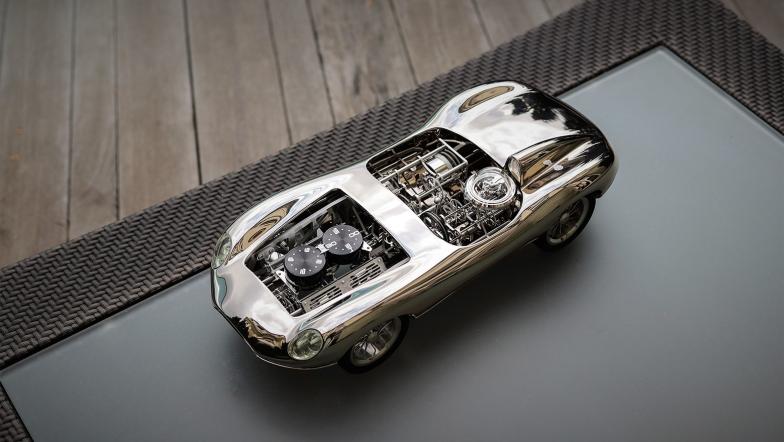

INSIGHTS
The floor and body are screwed to a H-chassis as in their full-sized counterparts. The body of Time Fast II is in aluminum because in the 1960s, aluminum was the high-tech material for racing cars as carbon fiber is today. An aluminum body on a race car offers a higher power-to-weight ratio, shorter braking distances, and faster cornering: all winning attributes in a sports car.
Time Fast II features two independent movements, both with their own power source. The first movement is in the cockpit and is responsible for keeping the time. Hours and minutes are displayed by rotating stainless steel disks on the air filters feeding the dual carburetor banks on top of the engine. The 8-day movement is regulated by a visible 2.5 Hertz escapement in the ‘driver’s helmet’ and powered by a mainspring visible in the passenger’s ‘seat’.
The second movement powers the engine automat. Turning the dashboard key starts the engine, triggering the pistons of the V8 to go up and down. This animation is completely independent of the time movement.
A manual gear lever selects between winding the time movement, winding the engine automate or neutral. Winding is accomplished by selecting the appropriate gear and pulling the car backwards.
The three-spoke steering wheel is assembled just as the original steering wheels were, with a center rim and two outer rims held together by 12 rivets. The steering wheel is turned counterclockwise to set the time, while turning clockwise allows repositioning of the wheel to center.
Highlighting just how much meticulous attention to detail L’Epée put into ensuring that Time Fast II is as accurate as possible to the cars that inspired it, the stainless-steel spoked wheel rims are crafted just like the real racing wheels were in the 1960s. The tires are in soft rubber for optimal grip when winding the movements and filled with a carefully selected foam compound so that the tires are slightly flat on the bottom to the same degree as real sport’s car racing tires on a real car racing track.
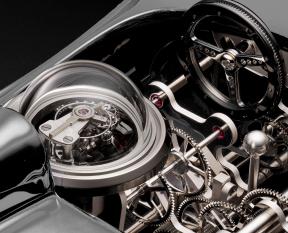
The pilot, steering wheel and gear box
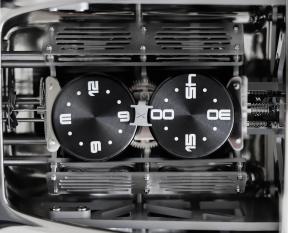
The time display
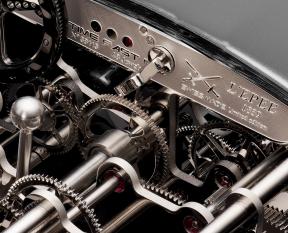
The dashboard with the contact key
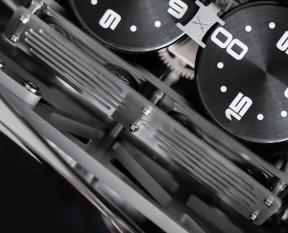
Engine animation
SPECIFICATIONS
Dimensions: 450 mm long, 189 mm wide, 120 mm high
Weight: 4.7 kg
Limited edition of 99 pieces
FUNCTIONS
Hour and minute displays on rotating disks
Time is set via counterclockwise rotation of the steering wheel, clockwise rotation repositions the steering wheel as desired
The clock is wound using the rear wheels
Reversing the car (and rotating the rear wheels) winds the mainspring barrels
A gear box lever selects which movement barrel is wound during winding
Time Fast II moves freely forwards and backwards in neutral
The key on the dashboard starts the engine piston automat
ENGINE / MOVEMENT
Tiered mechanical movement, L’Epée 1839 1855 MHD in-house caliber
Escapement: 2.5 Hz/18,000 bph
26 jewels
Power reserve: 8-days
Materials: Palladium-plated brass, polished stainless steel,
Incabloc protection system
BODYWORK & WHEELS
Blown glass dome, machined and polished to simulate the driver’s helmet
Top and bottom bodywork in aluminum
12-spoked rims in stainless-steel
Tires in soft compound rubber with foam inside offering authentic deformation of the tire on the ground
MATERIALS & FINISHINGS
Materials: palladium-plated brass, stainless steel, anodized aluminum
Finishes: Polished, satin-finished and sand-blasted movement / polished and satin-finished rims / Silver Chrome bodywork
special features

Time Fast’s lever gear selects which mechanism to recharge and the key activates the animation
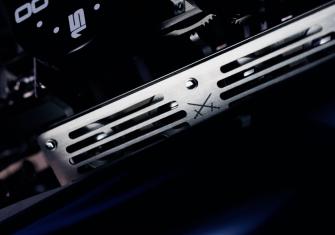
The V8 Engine
Reference
Silver Chrome
AVAILABLE Add to cart
44'370 CHF excl. VAT
